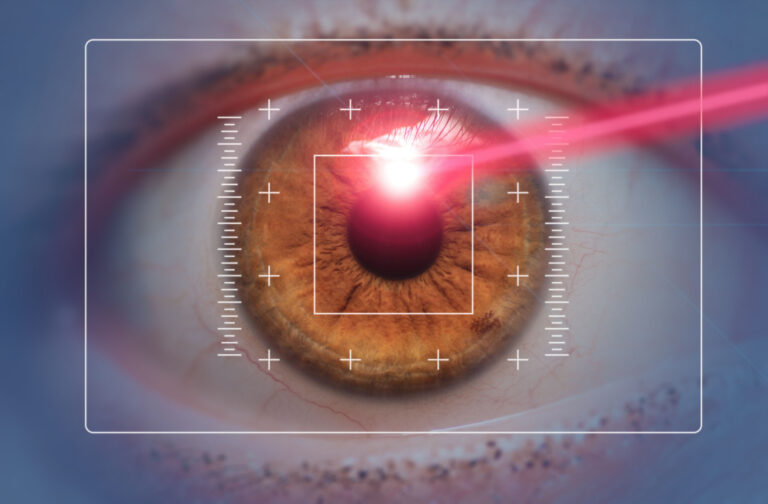Table of Contents

What Is SMILE Eye Surgery? [SMILE(全飞秒)近视手术 是什么?]
Eye problems can significantly affect your life—from impacting your daily activities to hindering the overall quality of life. You don’t have to let vision problems hold you back, though, as technology has made it possible to treat and correct vision problems using various refractive surgeries to leave contacts and frames behind.
The SMILE eye surgery is among the latest options for vision correction. It’s an alternative to LASIK that uses lasers to reshape the cornea. Your optometrist can help you learn if SMILE is right for you!
What Is SMILE?
SMILE stands for small incision lenticule extraction. This minimally invasive eye surgery uses a laser to reshape your cornea and nearsightedness (myopia), a refractive error that causes distant objects to appear blurry.
Understanding Myopia
Your eye is like a camera. Light enters through the cornea (the eye’s clear front surface) and forms an image on the back of the eye’s surface, called the retina. The retina converts this image into electrical signals that travel through the optic nerve to the brain, where the image is processed and interpreted. The lens, a clear structure behind the iris, adjusts its shape to focus light onto the retina.
Myopia occurs when the eye grows too long or the cornea is too curved, causing light to focus in front of the retina instead of directly on it, resulting in blurry vision when looking at objects in the distance.
Myopia is usually diagnosed during childhood, and your optometrist may recommend myopia control to slow its progression. Glasses and contact lenses are excellent for correcting myopia in children. But for adults, refractive surgery is a more permanent option.

Who Is a Candidate for SMILE?
Before having SMILE eye surgery, your eye doctor will need to evaluate your overall eye health and determine if you’re a good candidate for the procedure. Firstly, SMILE is for those with myopia, and even people with high myopia (up to -10.00 diopters) may benefit!
Some factors can impact your suitability:
- Your myopia prescription is unstable
- You have a condition that could interfere with healing
- You’ve had previous specific eye infections
- You have an eye disease
- You have a history of eye surgery
- You have eye scarring or keratoconus
- You have a corneal disease or abrasions
- You have advanced glaucoma
- You have uncontrolled diabetes
- You are pregnant or currently nursing
If you’re cleared for the surgery, your surgeon will discuss the details of the procedure and answer any questions you have. You’ll also need to schedule follow-up appointments to have your eyes measured and mapped for the SMILE surgery.
The SMILE Procedure
On the day of your surgery, your eye doctor will prepare you for the procedure by applying numbing eye drops and may offer a sedative to help you relax. They’ll program the laser with your eye’s measurements, telling it the precise area of your cornea that will be reshaped.
Once you’re ready, the surgeon will put an eyelid holder in your eyes to keep them open and prevent you from blinking. While this may sound uncomfortable, the holder is made of soft, rubber-like material. You’ll typically only feel a little pressure.
The femtosecond laser creates a tiny, lens-shaped piece of tissue (called a lenticule) in the cornea. This entire laser-cutting process usually only takes 30 seconds. Your surgeon will remove the lenticule through a small incision in the cornea, which won’t require stitches.
After the Procedure
After the surgery, your surgeon will go over instructions on caring for your eyes while they heal. You’ll need someone to drive you home, and you should plan to relax for the rest of the day. SMILE has a typically shorter recovery time than other refractive surgeries, like LASIK.
Benefits of SMILE Eye Surgery
Research shows that SMILE surgery produces similar visual acuity to LASIK. This procedure only requires a small corneal incision, making SMILE a minimally invasive surgery requiring minimal downtime. This small incision also lowers the risk of dry eye symptoms caused by laser surgery and could help your cornea retain its strength.
Even with the small incision, SMILE is noted for correcting high myopia, a benefit for people struggling with high eyeglass prescriptions.
Get Ready to SMILE
Vision problems can be frustrating, but with the proper treatment, they don’t have to be. SMILE is an effective eye surgery to help you see clearly without glasses or contacts. It’s not for everyone, but the first step is talking to your eye doctor.
To learn if you’re a candidate for SMILE or other refractive surgeries, contact our team at Golden Vision. We’re transforming lives with myopia solutions, and we’d love to see how we can help you. Book a consultation today!

